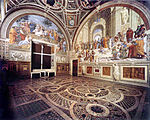Apostolic Palace

The Apostolic Palace (Latin: Palatium Apostolicum; Italian: Palazzo Apostolico) is the official residence of the pope, the head of the Catholic Church, located in Vatican City. It is also known as the Papal Palace, the Palace of the Vatican and the Vatican Palace. The Vatican itself refers to the building as the Palace of Sixtus V, in honor of Pope Sixtus V, who built most of the present form of the palace. The building contains the papal apartments, various offices of the Catholic Church and the Holy See, private and public chapels, Vatican Museums, and the Vatican Library, including the Sistine Chapel, Raphael Rooms, and Borgia Apartment. The modern tourist can see these last and other parts of the palace, but other parts, such as the Sala Regia (Regal Room) and Cappella Paolina, had long been closed to tourists, though the Sala Regia allowed occasional tourism by 2019. The Scala Regia (Regal Staircase) can be viewed from one end and used to enter the Sala Regia. The Cappella Paolina remains closed to tourists.
Excerpt from the Wikipedia article Apostolic Palace (License: CC BY-SA 3.0, Authors, Images).Apostolic Palace
Stradone dei Giardini,
Geographical coordinates (GPS) Address External links Nearby Places Show on map
Geographical coordinates (GPS)
| Latitude | Longitude |
|---|---|
| N 41.903611111111 ° | E 12.456388888889 ° |
Address
Palatium Apostolicum
Stradone dei Giardini
00120 , Vatican City
Vatican City
Open on Google Maps







